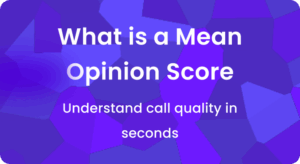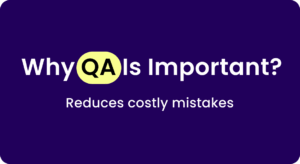Since its launch, ChatGPT has become the talk of the town. Developed by OpenAI, this groundbreaking language model has been causing a stir in the tech world due to its capacity to produce text that is similar to human language.
You can gauge the popularity of ChatGPT from the fact that it managed to cross 1 million users within 5 days of its launch and reached 100 million users within two months.
Currently, ChatGPT has 1.16 billion users from composing emails to writing essays and simply generating ideas, people are eager to put it to the test, and call centers are no exception to the ChatGPT trend.
In this article, we will understand 10 ChatGPT best practices in call center
These practices have been carefully curated to maximize the benefits of ChatGPT, enhance customer experiences, and optimize call center operations.
By following these approaches, the contact centers can harness the full potential of ChatGPT and unlock new levels of efficiency and customer satisfaction.
A. What is ChatGPT for call center?
ChatGPT is a language model developed by OpenAI that utilizes natural language processing to generate human-like text responses.
It is designed to engage in conversational interactions and provide relevant information or responses based on the input it receives.
While the presence of AI in contact center such as chatbots, voice-to-text analytics and speech recognition is not a new phenomenon, their previous iterations often left us with clunky navigation and robotic responses.
We may have encountered them on websites or as customer service assistants on food delivery apps.
However, ChatGPT goes beyond the typical chatbot capabilities.
It stands out by offering more than just basic question-answering functionality. ChatGPT has the ability to provide life advice, debug code, compose poetry, and even tackle a wide range of diverse tasks.
Pro tip💡
Harness the power of conversational intelligence software to transform your understanding of customer interactions and elevate your engagement strategies to new heights.
B. 10 ChatGPT best practices in call center environments.
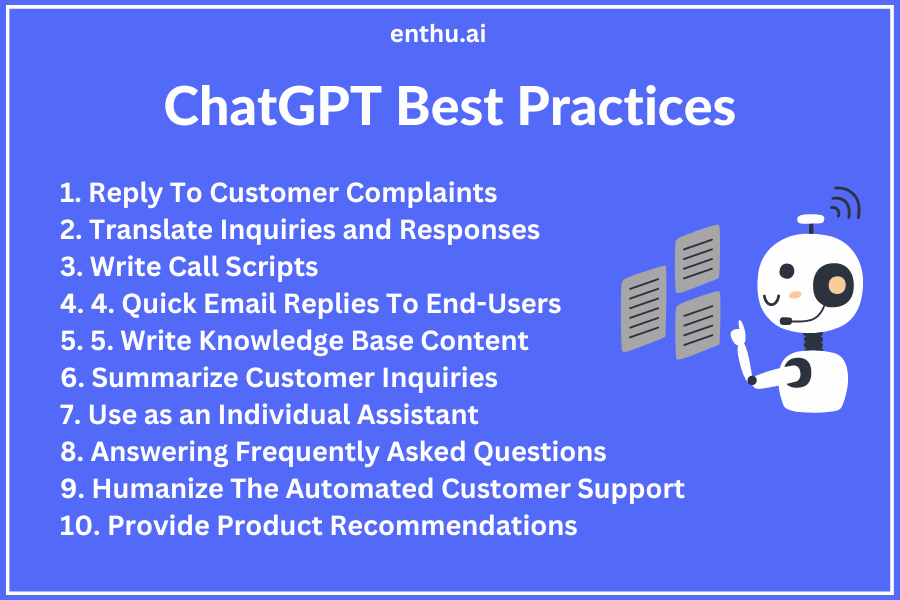
1. Reply To customer complaints, inquiries, and reviews
Replying to customer complaints, inquiries, and reviews is an important aspect of effective customer service.
ChatGPT can assist in this process by generating initial draft responses to customer complaints, inquiries, and reviews.
In a call center environment, service agents often need to respond to customer complaints and reviews across different channels, such as email, social media, and product review websites.
Imagine a scenario where the contact center agent receives a negative customer review on a popular online review platform.
The review highlights a specific issue the customer faced with a product and expresses dissatisfaction with the company’s service.
In this case, the agent can leverage ChatGPT to draft a response to address the customer’s concerns.
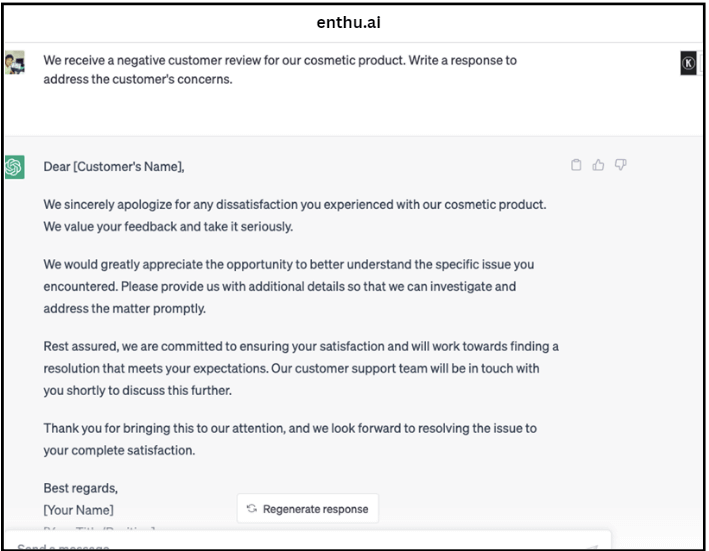
Similarly, in situations where there are negative customer reviews on social media or product review platforms, agents can leverage ChatGPT to compose concise responses within character limits.
By specifying the desired response length, agents can receive short-form responses that can be used to address customer concerns and provide appropriate feedback.
By using ChatGPT to generate initial drafts, agents can save time and effort in crafting responses, enabling them to handle customer complaints and reviews more efficiently.
However, human oversight and customization remain crucial to ensure the final response meets the organization’s standards and reflects its unique brand voice.
Pro tip💡
Use speech analytics software to analyze conversations and gain insights for better decision-making.
2. Translate inquiries and responses
In today’s globalized world, numerous organizations cater to customers worldwide, necessitating the provision of services in multiple languages.
Here’s how ChatGPT can help call center agents translate inquiries and responses:
a. Language Barrier Mitigation
In a multilingual call center, customers may reach out in their native language, which may not be understood by the agent.
By leveraging ChatGPT’s translation capabilities, agents can input the customer’s inquiry in their language, and ChatGPT can generate a translated version in the agent’s language.
This enables agents to understand the customer’s request and respond appropriately.
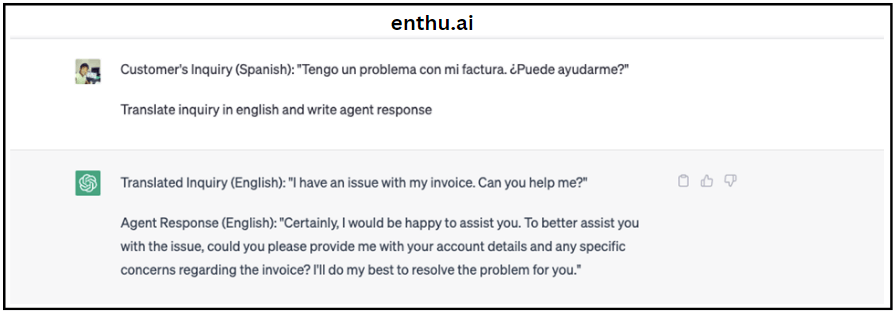
b. Real-Time translation
ChatGPT can facilitate seamless conversations by providing the real-time translation of both customer inquiries and agent responses.
This ensures smooth communication and allows agents to address customer concerns promptly.
c. Language flexibility
ChatGPT’s translation capabilities are not limited to specific language pairs.
It can be trained to handle multiple languages, enabling agents to provide support in various linguistic contexts.
This versatility allows contact centers to cater to customers from different regions and serve a diverse customer base.
Make sure that you are using a correct ChatGPT prompt.

3. Write call scripts
A call script is a document that outlines the flow of a phone conversation between a customer and an agent.
It serves as a guide for the agent to ensure that they cover all relevant topics and provide accurate and consistent information to customers.
Here are some recommended practices for utilizing ChatGPT to create effective call scripts in call center environments:
a) Identify common customer inquiries
The first step in creating a call script is to identify common inquiries that customers have when they call.
This information can be gathered from previous call records, surveys, and customer feedback.
b) Outline the call flow: Once you have identified the common inquiries, create an outline of the call flow.
This should include an opening greeting, a brief introduction, the main purpose of the call, and a closing statement.
c) Write the script: Using the outline, write a script that includes all the necessary information and key phrases.
Be sure to include alternative responses to different scenarios and objections that the customer may raise.
d) Test and refine the script: After creating the script, test it out with different agents and refine it based on their feedback.
Make sure the script is easy to follow, relevant to the customer’s needs, and provides accurate information.

4. Quick email replies to end-users
ChatGPT can automate the process of generating email responses, allowing agents to quickly draft and send replies to end-users.
This saves time and effort, enabling agents to handle a higher volume of emails and respond promptly to customer inquiries.
Moreover, ChatGPT can be trained on predefined email templates that cover common scenarios and frequently asked questions.
Agents can leverage these templates to generate consistent, well-structured email responses.
Standardized templates ensure that the necessary information is included and help maintain a professional and coherent communication style.
Pro tip💡
Leverage Call center quality monitoring software to assess performance and improve customer satisfaction.
5. Write knowledge base content
Developing a knowledge base allows you to create a centralized repository of information that agents can access. This repository contains articles, guides, FAQs, troubleshooting steps, and other resources related to products, services, and common customer inquiries
ChatGPT can assist in generating content for the knowledge base, ensuring that it is comprehensive and up-to-date.
A well-structured knowledge base empowers customers to find answers to their questions independently. By providing comprehensive and easily searchable content, customers can access information and resolve issues without needing to contact support agents.
This reduces the overall support volume and allows agents to focus on more complex or specialized customer inquiries.
6. Summarize customer inquiries
ChatGPT can assist in summarizing customer inquiries by extracting key details and condensing them into concise summaries.
This helps agents quickly grasp the main points of the customer’s issue or question without having to read through lengthy messages or listen to lengthy recordings.
By using AI call summary and ChatGPT to summarize customer inquiries, agents can save time and streamline their workflow.
They can focus on addressing the specific concerns raised by customers rather than spending excessive time deciphering and understanding the entirety of each customer interaction.
7. Use as an individual assistant
ChatGPT in call centers can be used as an advisor to customer service representatives, augmenting their existing processes rather than replacing them entirely.
It can assist in situations where representatives encounter repetitive tasks or face questions they are unsure of how to answer.
For example, when a customer inquiry requires reaching out to a supervisor or another department, the representative can use ChatGPT to quickly find the answer without putting the customer on hold or transferring the call.
This not only improves customer satisfaction by avoiding transfers but also allows representatives to handle more calls and reduce the need for additional staff.
The use of ChatGPT as an advisor maximizes efficiency and minimizes the time spent on seeking information, benefiting both the company and the customer.
8. Answering frequently asked questions
ChatGPT can be trained using the company’s FAQ page or knowledge base to effectively recognize and address common customer questions.
Whenever a customer submits a query, ChatGPT carefully analyzes the message and generates a response that directly addresses their question or directs them to relevant resources for further assistance.
Leveraging ChatGPT to answer FAQs in call centers brings significant advantages.
Firstly, it significantly improves customer satisfaction by providing quick and accurate responses, reducing wait times, and ensuring customer needs are promptly met.
Secondly, it lightens the workload of human customer service representatives, allowing them to focus on more complex inquiries that require personalized attention.
This not only enhances operational efficiency but also allows agents to deliver a higher quality of service.
By harnessing the power of ChatGPT’s ability to understand and respond to frequently asked questions, call centers can streamline their operations, deliver consistent and reliable support, and ultimately elevate the overall customer experience to new heights.
9. Humanize the automated customer support
ChatGPT is designed to understand and respond in a conversational manner, mimicking human-like interactions.
It uses natural language processing techniques to interpret customer queries and generate responses that sound more human.
By incorporating personalized greetings and empathetic language in the responses, ChatGPT can create a more engaging and compassionate customer experience.
It can acknowledge customer emotions, show understanding, and provide reassurance or empathy when appropriate.
ChatGPT can be trained to match the preferred tone and style of the organization.
This ensures that the responses align with the company’s brand voice and values, making the interactions feel more human and consistent.
10. Provide product recommendations
Product recommendations using ChatGPT in call centers leverage the power of customer data analysis to offer personalized suggestions.
By examining customer preferences, purchase history, and browsing behavior, ChatGPT can generate tailored recommendations that align with individual customer interests.
For example, if a customer has recently purchased a camera, ChatGPT can suggest complementary accessories or related products like lenses, tripods, or camera bags.
This not only enhances the customer’s shopping experience by providing relevant suggestions but also increases the potential for cross-selling and upselling.
By presenting customers with personalized recommendations, call centers can foster customer engagement, increase sales, and drive customer satisfaction.
Conclusion
From replying to customer complaints, inquiries, and reviews, to translating inquiries and responses in multiple languages, ChatGPT proves to be a valuable tool.
By implementing these ChatGPT best practices in a call centers can optimize their operations, increase customer satisfaction, drive sales and revenue growth and establish lasting customer relationships.
In conclusion, ChatGPT presents a significant opportunity for call centers to revolutionize their customer service approach and stay ahead in the ever-evolving landscape of customer support.
FAQs
1. How can ChatGPT help in customer service?
ChatGPT can assist in customer service by providing quick responses to common inquiries, offering personalized recommendations, troubleshooting issues, and guiding customers through processes, enhancing overall efficiency and customer satisfaction.
2. Can ChatGPT be used as a call center?
While ChatGPT can provide text-based customer support, it is not designed for handling voice calls. It is more suitable for chat-based interactions and may not have the necessary capabilities for a call center environment.
3. What is best practice in call center?
Best practices in call centers include effective training for agents, clear communication protocols, efficient call routing, regular performance monitoring and coaching, and prioritizing customer satisfaction through empathy and problem resolution.
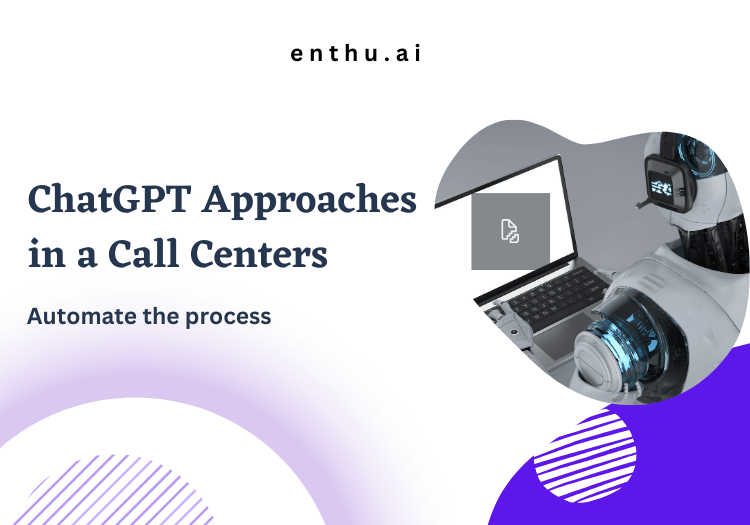


 On this page
On this page

